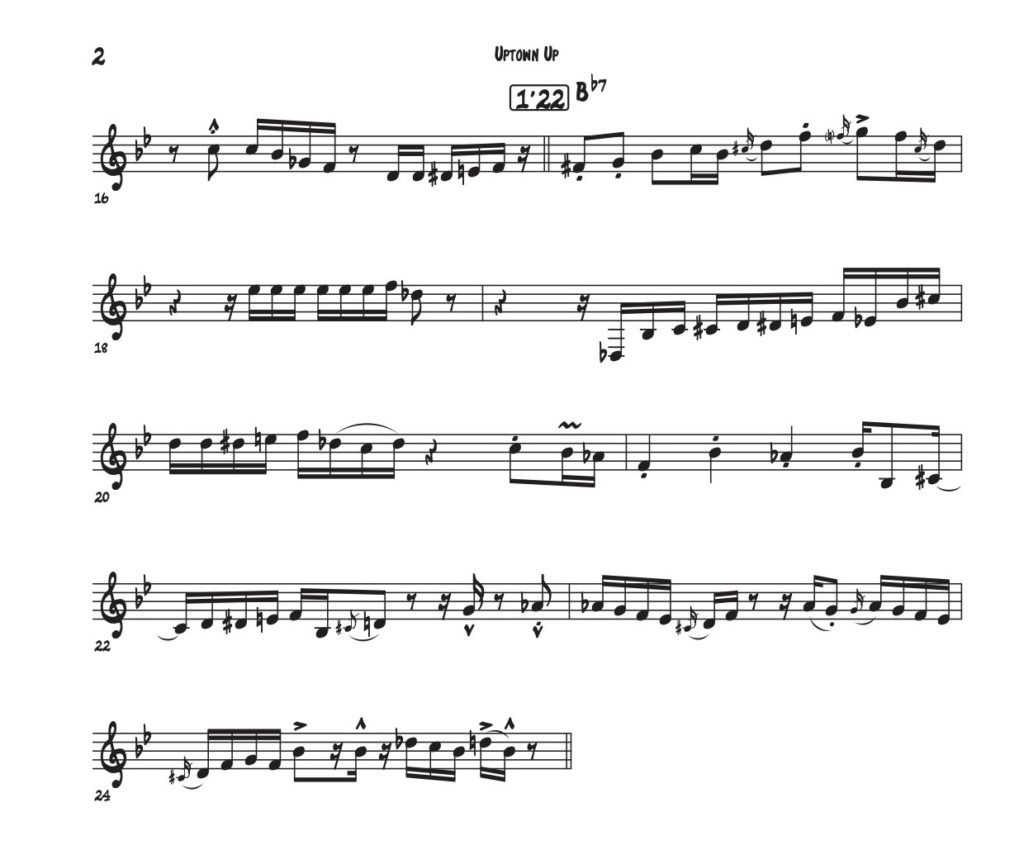

Methodical analysis of the melodic content
Passages¹ where Maceo uses the major blues scale:
- [ bar 0 – bar 3/beat 3 ]: Bb major blues
- [ bar 5/beat 3 – bar 7/beat 1 ]: Bb major blues
- [ bar 8/beat 3 ]: Bb major blues
- [ bar 8/beat 4 – bar 11 ]: C major blues
- [ bar 13/beat 4 – bar 15/beat 1 ]: C major blues
- [ bar 17 ]: Bb major blues
- [ bar 24 ]: Bb major blues
Passages¹ where Maceo uses the minor blues scale:
- [ bar 3/beat 4 – bar 5/beat 2 ]: Bb minor blues
- [ bar 7/beat 2 – bar 8/beat 2 ]: Bb minor blues
- [ bar 15/beat 2 – 16/beat 2 ]: C minor blues
- [ bar 18 ]: Bb minor blues
Passages¹ where the major and minor blues scales are intertwined:
- [ bar 12 – bar 13/beat 3 ] with, in particular, an ascending chromatic motif (D# E F F# G) [ bar 12/beat 2 – bar 12/beat 4 ], which includes notes from the C major blues scale (E) as well as the C minor blues scale (F, F#). Both scales are indeed commonly used to improvise over the C7 chord;
- [ bar 16/beat 3 – bar 16/beat 4 ], a short ascending chromatic motif (D D D# E F) including notes from both the Bb major blues scale (D) and the Bb minor blues scale (D#, E). This sets up the return to the Bb7 chord in bar 17 (anticipation)²;
- [ bar 19 – bar 20/beat 3 ], a phrase based around two very similar ascending chromatic motives (C C# D D# E F and C# D D# E F), the second of which is played an octave above the first. Again, notes from both the Bb major blues scale (C, D) and the Bb minor blues scale (D#, E) are featured here, being tones of choice to improvise over the Bb7 chord;
- [ bar 20/beat 4 – bar 21/beat 3 ], the presence of the notes C (from Bb major blues) and Ab (from Bb minor blues) together in this segment evoke the Bb Mixolydian mode, another natural choice to improvise over the Bb7 chord;
- [ bar 21/beat 4 – bar 22/beat 2 ], here we have the pattern C# D D# E F again, with the note D from Bb major blues, and the notes D# and E from Bb minor blues (C# and F are common to both scales);
- [ bar 22/beat 3 – bar 23 ], a diatonic descending motif (Ab G F Eb D), which again clearly evokes Bb Mixolydian. While Ab and Eb belong to Bb minor blues, G and D belong to Bb major blues (F being common to both scales).
Key takeaways
Based on this transcription, two distinct patterns, characteristic of Maceo Parker’s style, stand out when he intertwines the major blues scale with its minor counterpart:
- an ascending chromatic motion from scale degrees 2/#2/3 up to scale degree 5;
- a descending diatonic (Mixolydian) motion from scale degree b7 down to scale degree 3.
In the first half of his solo, Maceo sets up the tone of his improvisation by shifting between the minor blues scale and the major blues scale, utilized as strictly separate entities. Beginning in bar 12, he gradually throws in more and more segments where both scales seamlessly intertwine. Between bars 19 and 23, he finally crafts a longer melodic sequence featuring both extensive chromaticism as well as diatonic ideas from Mixolydian, before wrapping up with a strong, effective major blues statement (bar 24).
Practice tip
Although Maceo’s rhythm, phrasing, and expression aren’t discussed in this post, they are also really hip and crucial to the powerful effect of his solo. Don’t neglect imitating these elements as accurately as possible on your instrument while practicing this transcription. Becoming familiar with the notes and scales is only half the work (at most)!
Notes
¹ Like in mathematics, the square brackets turned towards the inside (like this ” […] ” as opposed to this ” ]…[ ” ) indicate that the bar/beat numbers signaled within the brackets are included in the passage under consideration.
² The F# played on bar 17/beat 1 does not belong to either of the Bb blues scales. Rather, it is a lower chromatic approach of the following note G (itself scale degree 6 of the Bb major blues scale). This part (bar 17/beat 1) can be seen as an extension of the ascending chromatic motion initiated in bar 16/beat 3.
References
Parker, Maceo. Funk Overload. What Are Records? 60032. 1998.
Visit https://funnelljazz.eu/lessons/ for detailed information about lessons or click on the image below to book your lesson today:

